Sous Vide Steak Recipe
Published March 8, 2024. This post may contain affiliate links. Please read my disclosure policy.
This incredible sous vide steak recipe is slow cooked in a water bath with herbs and garlic that is then pan seared to golden brown perfection for the ultimate meal. Once you try this method of cooking steak, there is no going back.
I do love a good steak, but sometimes they are just so expensive when I order it when I’m out to eat. If you feel the same way, check out my Steak Diane or Grilled T Bone.
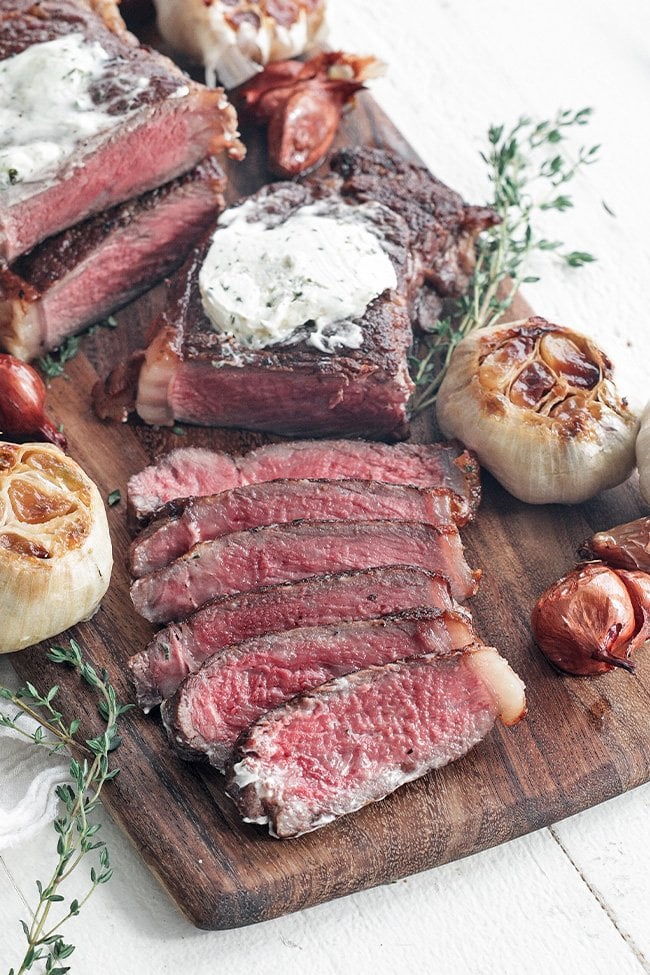
Sous Vide Steak
Sous vide steak is a beef steak that has been sealed in an airtight bag and slowly cooked in a container or pot of temperature-regulated water using a sous vide machine or wand. The term sous vide is French for “under vacuum,” regarding the sealed bag the steak is in and cooked under a vacuum.
The sous vide wand regulates the water to a precise temperature and holds it at that temperature. There is a heater in the wand and a vacuum fan that constantly moves to circulate the water to ensure it stays at the desired temperature. During this process at low temperatures the fat will slowly melt and render throughout the steak making it extremely flavorful while retaining an incredible amount of moisture to keep it juicy.
Ingredients and Substitutions

- Steak – Any boneless or bone-in cut of sirloin, filet, ribeye, flank, skirt, top round, hanger, T-bone, or porterhouse steak will work for this. I used a New York Strip Steak.
- Oil – I believe olive oil is the best for searing a steak to create the perfect Maillard reaction. Other options are avocado oil, ghee, clarified butter, or beef tallow.
- Butter – I always use unsalted butter in all my cooking and baking to control the sodium content.
- Seasonings – coarse salt and freshly ground black pepper is all that was used for this reverse-seared steak.
- Herbs – I used fresh thyme sprigs to enhance the flavor of the steak during the sous vide and searing process. Other herbs you could use are rosemary, sage, or oregano.
- Garlic – A few garlic cloves will add beautiful flavors to the dish.
- Shallots – I like to use 1 shallot when searing the steak for a bit of onion flavor.
How to Make Sous Vide Steak
Pat dry the steak on all sides with a paper towel.

Season the steak on all sides with coarse salt.
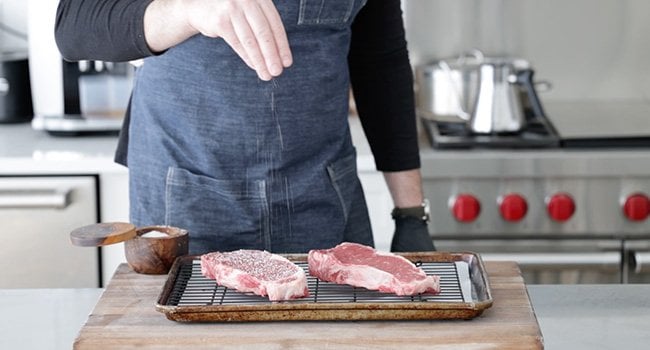
Place it on a rack over a sheet tray and in the refrigerator uncovered for 2 to 24 hours.
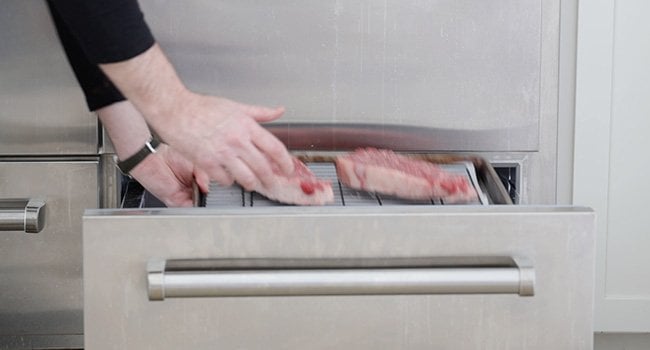
When ready to prepare it, add a sous vide wand to a large pot or container filled ¾ of the way with cold water.
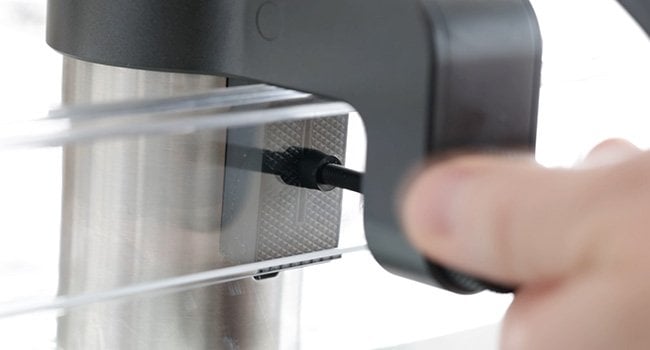
Preheat the wand to 100°.
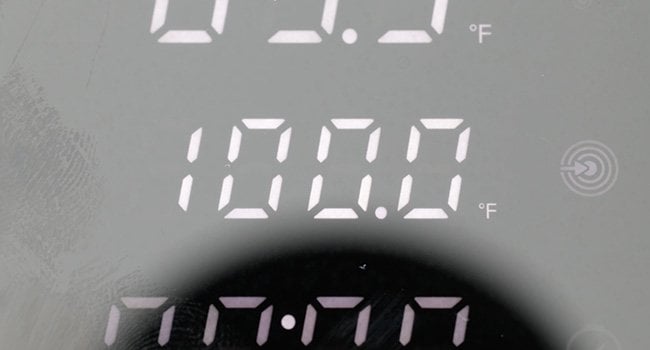
Remove the steak from the refrigerator and season it on both sides with freshly ground black pepper.
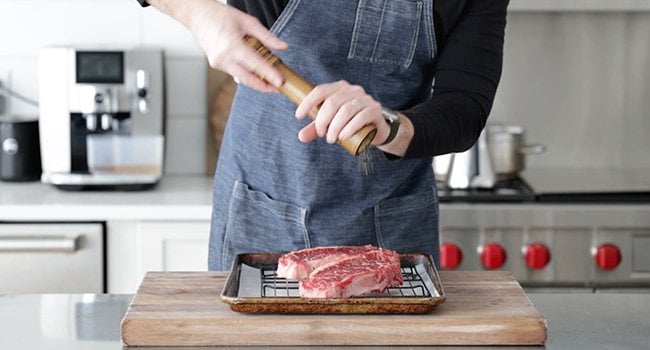
Add your steak to a large vacuum seal bag with 3 to 4 sprigs of fresh thyme and 4 garlic cloves.
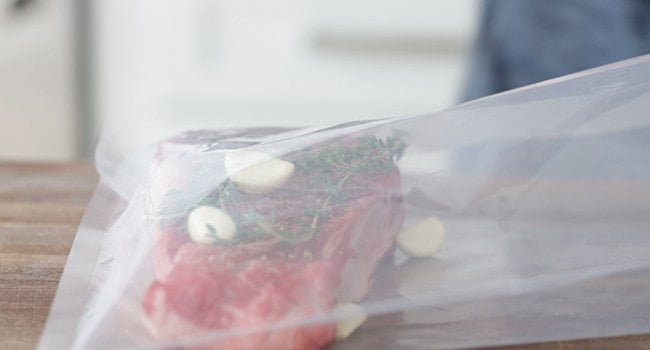
Seal the vacuum bag until compressed and airtight. Please see my video on how to use a plain plastic zip bag to achieve a very similar process.
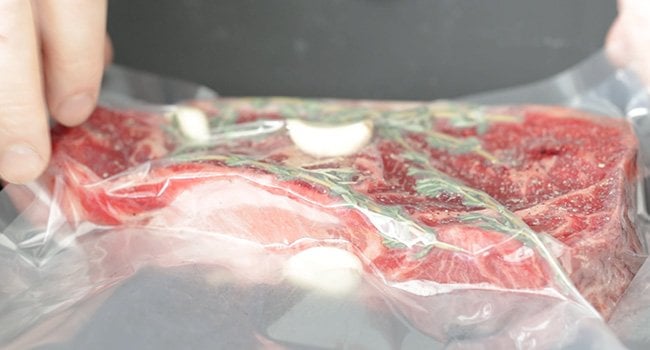
Submerge the steak in the sealed bag into the container or pot. Cook at 100° for 1 to 2 hours.
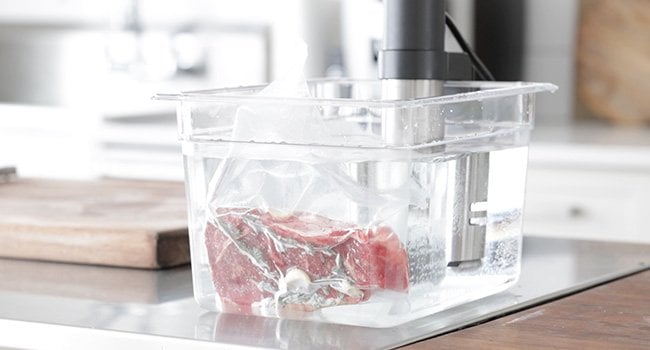
Remove the bag from the water and then remove the steak from the bag.
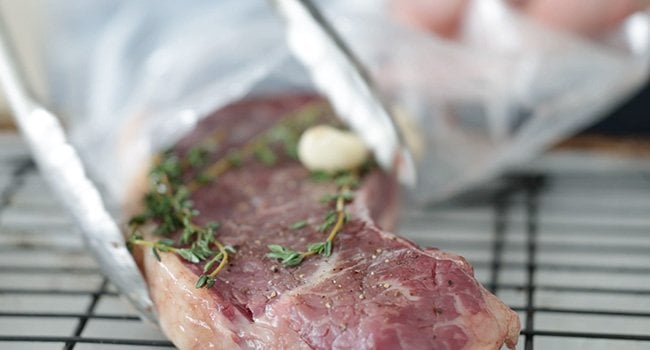
It will have been sitting in its own rendered juice and fat for a few hours so to ensure it gets a good brown crust, pat it dry on all sides with a paper towel.
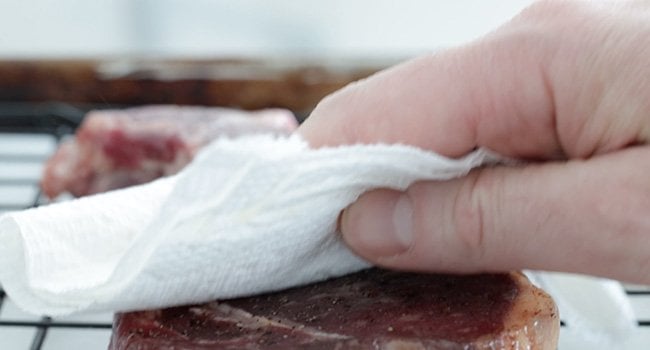
Add the olive oil to a 10” cast iron or carbon steel pan and heat over high heat until the oil smokes lightly.
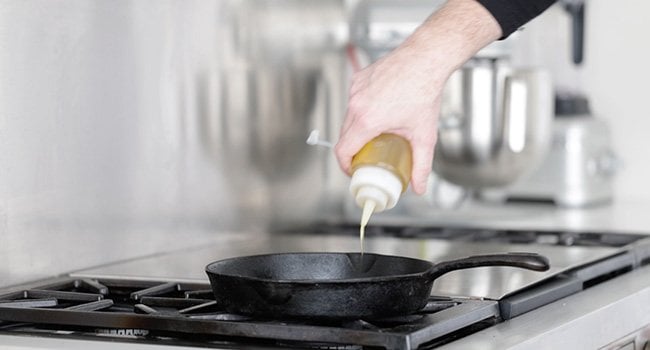
For a medium rare internal steak, place the steak in the pan turn the heat down to medium and let the steak cook for 1 minute.
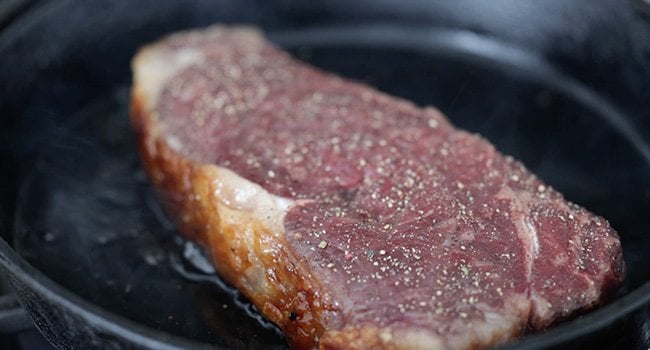
Next, using tongs, move the steak around in a circular motion for 1 minute. Doing this will help completely brown the top of the steak, which is known as a Maillard crust.
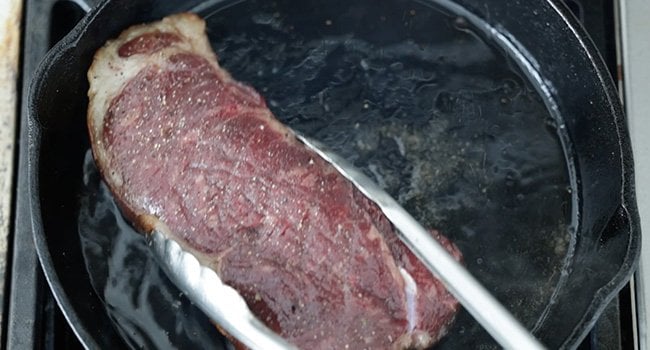
Flip the steak over turn the heat down to low-medium and cook it for 1 minute.
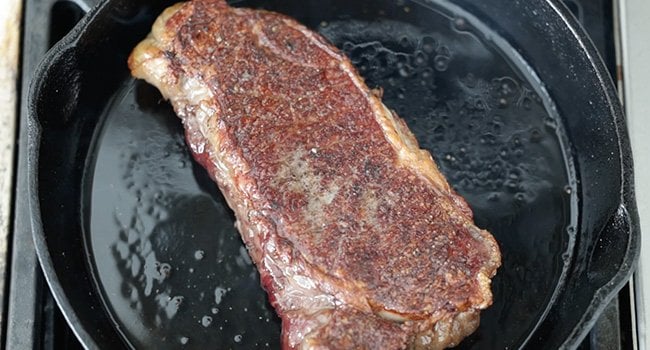
Add the garlic, shallots, thyme, and butter to the pan with the steak.
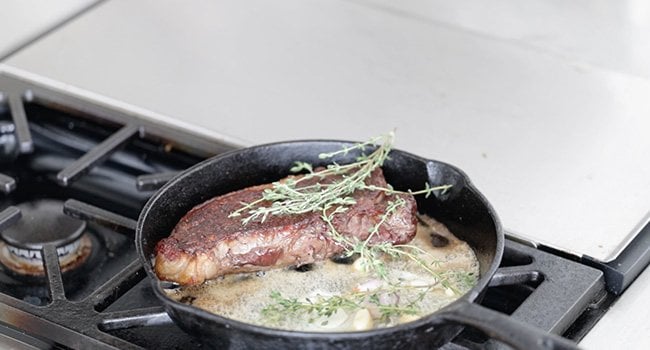
Baste the steak for 2 minutes to help brown and flavor the steak more.
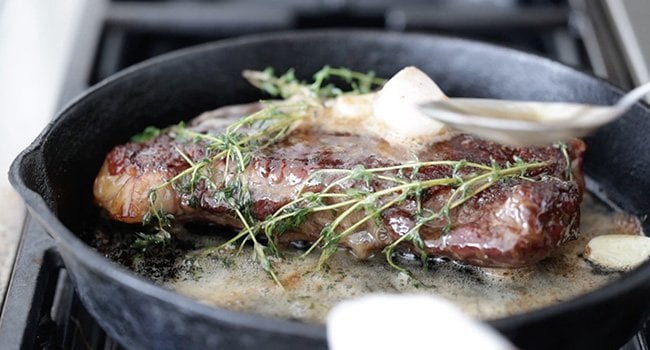
Let the steak rest for 3 to 4 minutes.
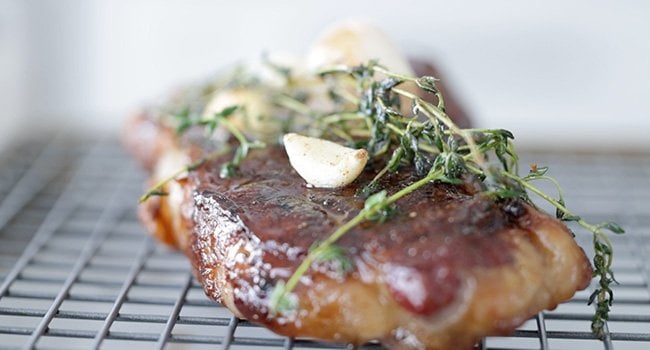
Slice the steak and serve it as is or with some Maître D’ Butter.
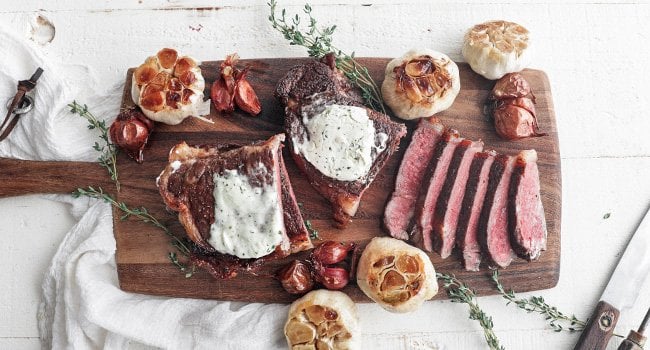
Make-Ahead and Storage
Make-Ahead: Sous vide steak is meant to be eaten as soon as it is done cooking.
How to Store: Cover and keep in the refrigerator for 3 days. This recipe will not freeze well.
How to Reheat: This recipe does not reheat well, but if you do need to reheat it, then re-sear it in a hot pan with lightly smoked oil until warm.

Chef Notes + Tips
- When the steaks are smaller in weight, you may need to adjust cooking times by 1 minute per side.
- Feel free to use your favorite steak seasoning.
- If you let the steak sit seasoned for more than 24 hours, it causes it to begin drying out.
- The best pans for searing the steak are cast iron or carbon steel. However, you can use whatever you have.
- Maillard reaction, also known as the browning reaction, is an interaction between sugar and amino acids in the steak when heated to 285°and 350° over high heat, browning the meat to enhance the flavor and add more crispness. This is not the same as caramelizing.
- Since I prefer my steak medium rare, I prefer to remove it from the oven at 100° internally so that I have more wiggle room when pan searing to ensure it is not overcooked.
- You will need at least a 12” pan to sear multiple steaks simultaneously.
- This is the sous vide wand I used.
- Please see my video on how to use a plain plastic zip bag to achieve a very similar process a vacuum sealed bag.
- When food is in the danger zone between 40° and 140° for longer than 2 hours, bacteria grows at an extremely fast rate which can lead to food borne illnesses.
- Sous vide is also an excellent way to slowly reheat food without overcooking.
More Steak Recipes

Video
Sous Vide Steak Recipe
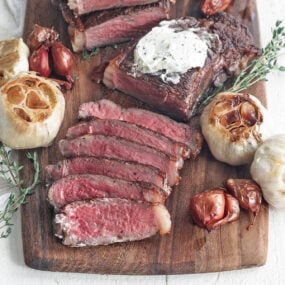
Ingredients
- 2 1-pound New York strip steaks
- 8 garlic cloves
- 20 sprigs fresh thyme
- 1 tablespoon olive oil
- 1 peeled shallot
- 4 tablespoons unsalted butter
- coarse salt and fresh ground pepper to taste
Instructions
- Start by patting dry the steak on all sides with a paper towel.
- Next, season the steak on all sides as you would before cooking it with coarse salt.
- Place it on a rack over a sheet tray and place it in the refrigerator uncovered for 2 to 24 hours.
- When you’re ready to prepare it, add a sous vide wand to a large pot or container that’s filled ¾ of the way with cold water.
- Preheat the wand to 100°.
- Remove the steak from the refrigerator and season it on both sides with freshly ground black pepper.
- Add your steak to a large vacuum seal bag along with 3 to 4 sprigs of fresh thyme and 4 garlic cloves.
- Seal the vacuum bag until compressed and airtight. Please see my video on how to use a plain plastic zip bag to achieve a very similar process.
- Submerge the steak in the sealed bag into the container or pot and cook at 100° for 1 to 2 hours.
- Remove the bag from the water and then remove the steak from the bag.
- It will have been sitting in its own rendered juice and fat for a few hours so to ensure it gets a good brown crust, pat it dry on all sides with a paper towel.
- Add the olive oil to a 10” cast iron or carbon steel pan and heat over high heat until the oil smokes lightly.
- For a medium rare internal steak, place the steak in the pan, turn the heat down to medium, and let the steak cook for 1 minute
- Next, using tongs, move the steak around in a circular motion for 1 minute. Doing this will help completely brown the top of the steak, which is known as a Maillard crust.
- Flip the steak over, turn the heat down to low-medium, and cook it for 1 minute. Add the garlic, shallots, thyme, and butter to the pan with the steak.
- Baste the steak for 2 minutes to help brown and flavor the steak more. Let the steak rest for 3 to 4 minutes.
- Slice the steak and serve it as is or with some Maître D’ Butter.

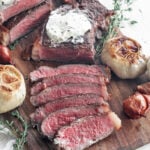
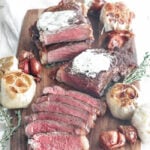

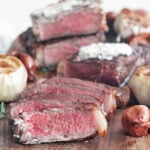
Made this today for early Sunday dinner. Hubby and I loved it. Had your German red cabbage left over and a few small potatoes left over. I used Garlic butter on it. Love it!
Excellent!
I’m now set up to do Sous Vide but have not done it yet. I see this is your only Sous Vide recipe. I’d like to see more so I can learn along with you.
Honestly it’s really the same process no matter what you put in it. I may do some more next year or the end of this year.
I just made this following your instructions. I always sous vide my steaks and then reverse sear but your techniques were great! The best I have ever made! I used a thick cut tenderloin (5oz) and a cast iron skillet (with olive oil). I didn’t have thyme but did have rosemary. This was outstanding and perfectly cooked to a medium-med rare. I will post pics on Facebook.
Excellent!
Shall give this 😋😁 to try your mouthwatering recipe Chef Billy thank you
In the sous vide video you mention that the reverse sear steak needs to go into the oven without convection, however this is not mentioned in the reverse steak video so I’m left wondering if this is incredibly important or not.
oven is always regular in all my recipes unless specified.
Have not made it, but, would love to try. I 🙋♀️🙏🏴
Many sous vide recipes call for way longer than 2 hours .
Such as pork ribs – and beef steak and roast.
Are you saying we are risk of food Bourne illness after just 2 hrs in the sous vide bath ?
correct. Those things can hold fine at 140+ for several hours.
I always sous vide my steaks similar to your recipe (a little different length of time), also with an Anova wand and then pan searing. Perfectly cooked! Sous vide is also wonderful for pork tenderloins and chicken…always tender and juicy!
it’s such a great way to cook food.